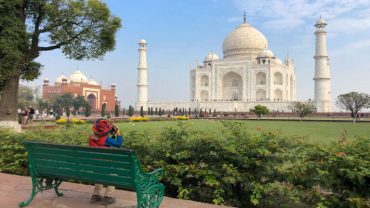A Walk through Time: Exploring Agra’s Heritage Beyond the Taj
Agra, the city that houses the iconic Taj Mahal, is a treasure trove of history and heritage that extends far beyond its most famous landmark. While the Taj Mahal takes center stage, a walk through Agra’s heritage offers a captivating journey through time, revealing a tapestry of cultural influences, architectural marvels, and a rich legacy waiting to be discovered.
Agra Fort: A Mughal Marvel
Agra Fort, a UNESCO World Heritage Site, is one of India’s most significant fortifications. Built primarily of red sandstone, it stands as a testament to the grandeur of the Mughal Empire. Commissioned by Emperor Akbar in 1565, the fort has seen subsequent additions and alterations by his successors, Jehangir and Shah Jahan.
As you explore Agra Fort, you’ll encounter a blend of Persian, Islamic, and Indian architectural elements. The Hall of Public Audience (Diwan-i-Am) with its imposing columns and the Private Audience Hall (Diwan-i-Khas) adorned with intricate carvings exemplify the Mughal architectural prowess. From the fort’s walls, you can also catch mesmerizing views of the Taj Mahal in the distance.
Fatehpur Sikri: The Abandoned City
Just a short drive from Agra lies Fatehpur Sikri, another UNESCO World Heritage Site, and a ghost city with a captivating history. Built by Emperor Akbar in the late 16th century, it served as the Mughal capital for a short period before being abandoned due to a scarcity of water. The red sandstone structures, including the imposing Buland Darwaza (Gate of Magnificence) and the tomb of Salim Chishti, offer a glimpse into the opulence of the Mughal era.
Fatehpur Sikri is a true architectural gem, and its well-preserved structures transport you back to the days of Mughal grandeur. The intricate carvings, expansive courtyards, and the stories etched in its stones make it a must-visit for history enthusiasts.
Akbar’s Tomb: A Serene Retreat
The tomb of Emperor Akbar, known as Sikandra, is a tranquil spot away from the bustle of the city. Surrounded by beautifully landscaped gardens, the tomb showcases a blend of Mughal and Indian architectural styles. The architecture is a precursor to the grandeur of the Taj Mahal and provides insight into the evolving styles of the Mughal dynasty.
Mehtab Bagh: A Taj Mahal Perspective
Mehtab Bagh, or the Moonlight Garden, is a symmetrical garden located across the Yamuna River from the Taj Mahal. It was designed to provide a perfect view of the Taj in moonlight, offering a different perspective of the iconic monument. Strolling through this garden at sunset, with the Taj Mahal as a backdrop, is a serene experience that allows you to appreciate the monument’s beauty from a unique vantage point.
The Jama Masjid: A Spiritual Oasis
The Jama Masjid in Agra is a place of worship and a piece of architectural excellence. Built by Shah Jahan, the same emperor who commissioned the Taj Mahal, this mosque is a fine example of Mughal architecture. The imposing structure features intricate design elements and a large courtyard where devotees gather for prayers. Visiting the Jama Masjid offers a chance to experience the spiritual side of Agra.
The Chini Ka Rauza: A Hidden Gem
The Chini Ka Rauza is a lesser-known gem in Agra’s heritage. It’s the tomb of Allama Afzal Khan Mullah, a scholar and poet in the court of Shah Jahan. The unique feature of this structure is its blue-glazed tiles, or “chini,” that adorn its façade, a rarity in Mughal architecture. The tomb and its garden offer a quiet retreat from the crowds, and the tiles add a touch of whimsy and color to the historical site.
Sadar Bazaar: A Taste of Local Culture
Sadar Bazaar, one of Agra’s bustling marketplaces, is not just about shopping; it’s a cultural experience. Here, you can immerse yourself in the sights and sounds of Agra. Explore shops selling local handicrafts, traditional clothing, and delicious street food. It’s a place to interact with locals and get a taste of Agra’s vibrant culture.
Conclusion: A Glimpse into Agra’s Rich Heritage
Agra’s heritage extends far beyond the Taj Mahal, and exploring it is like taking a walk through time. The city’s forts, monuments, and gardens bear witness to the grandeur of the Mughal Empire and the cultural influences that shaped this region. From the imposing Agra Fort to the abandoned beauty of Fatehpur Sikri, from serene gardens like Mehtab Bagh to the lesser-known architectural marvels, Agra’s heritage is a testament to the depth of history and culture waiting to be discovered.
So, when you visit Agra, don’t just limit your exploration to the Taj Mahal. Take the time to discover the city’s rich tapestry of heritage that will transport you to bygone eras and leave you with a deeper appreciation of India’s historical legacy.




Comment (0)